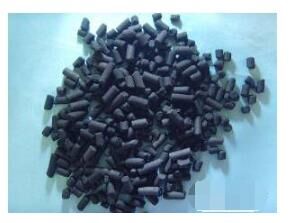Overview of mold inhibitors for coatings
Abstract: The properties, action mechanism, performance requirements and classification of mold inhibitors are outlined, several types of main mold inhibitors are introduced, and the current status and prospects of the application of mold inhibitors in coatings are reviewed.
Keywords: mold inhibitor; nature; application; coating

Anti-mold agent is a class of polymer material additives that can inhibit the growth of molds and kill molds, which can make polymer materials free from fungal erosion and maintain good appearance and physical and mechanical properties. The film-forming material of coatings consists of various natural and synthetic polymer compounds, which are subject to the destructive effects of environmental factors such as oxygen, heat, light, chemical aggressors, etc., as well as to the destruction of various organisms such as molds. Paint contaminated by microorganisms, viscosity loss, pigment settling, odor, gas, container expansion, pH drift and system damage and other phenomena, known as spoilage. In solvent based coatings, spoilage is not a prominent problem. Mildew erodes the coating film, causing color change, sticking, perforation, destruction and peeling of the coating film, loss of adhesion, affecting the protective properties of the coating film and the neatness and appearance of the material, reducing the mechanical properties, shortening the service life, and posing hazards to environmental health.
Coatings used in natural polymer materials containing casein, soy protein, alginate, starch, natural gum, cellulose derivatives, fat and other substances that can be ingested by mold, susceptible to mold. Most of the synthetic polymer materials are very strong antimicrobial, some varieties (such as polyurethane, polyacrylate, polyvinyl acetate, polyvinyl alcohol, perchloroethylene, vinylidene chloride, etc.) due to its structure, the bacterial resistance is poor, easy to be decomposed by mold. Coatings used additives (such as plasticizers, heat stabilizers, light stabilizers, organic fillers, colorants, etc.), both the nutrient source of mold, many varieties or colonial substances, adding these additives is often the main cause of paint and coating film bacterial damage. Adsorption of dust on the surface of the film is also a source of nutrients for mold.

1 Mechanism of action
Corrosive coatings and films of mold belongs to the fungi, Aspergillus sachs, Aspergillus flavus, Aspergillus niger, Aspergillus albus, Aspergillus constructosus, purple penicillium, Penicillium extensum, Penicillium disorganized, penicillium anisopliae, wood mold, cephalosporin mold, bud mold, lose the branches of the mold, glucosporinomycetes, sprouting thrive mold. Mold is a wide variety of microbial groups, distributed in the soil, water, plant and animal bodies or air, almost everywhere. Molds rely on other objects to absorb nutrients, parasitic or putrefactive way to survive, can secrete a variety of enzymes, the organic matter into easy to take in the nutrients. As long as there is a very small amount of nutrients, in the appropriate temperature (26 ~ 32 ℃) and humidity (> 85%), mold can grow and multiply.
The killing effect of mold inhibitors on mold is to enter the cell through the cell membrane of the spore, hindering the germination of the spore or killing the spore. Antifungal agent on the toxic effect of mold including the following ways: eliminate or inhibit the activity of various metabolic enzymes in the mold cell; and enzyme protein amino or sulfhydryl reaction, inhibition or destruction of its function; inhibit the synthesis of RNA in the germination of spores, thus preventing the germination of spores; accelerate the promotion of the phosphoric acid oxidation-reduction system, in order to destroy the cell’s function; destruction of the energy release system of the mold cell; inhibition of the electron transfer system and transaminase system, etc.
2 Performance requirements
Ideal mold inhibitor in the practical application should meet the following conditions: erosion of paint and coating film of various mold has a very high ability to kill, the dosage is small, a wide range of applications, long-lasting effectiveness; harmless to animals and humans, low toxicity or non-toxicity, non-irritating effect on the skin and eyes; does not affect the physical properties of the paint and coating film, chemical properties; high stability, good resistance to heat, light and chemicals, sublimation is small, and not easily extracted by water, oil or solvents. Water, oil or solvent extraction; good compatibility with resin and other additives, no harmful chemical reaction; no corrosion or galvanic corrosion of metal or various materials; no odor, light color, no pollution; easy to use, low price. R & D fully meet the above requirements of the mold inhibitor is more difficult, sometimes even impossible. Various mold inhibitor itself has its own characteristics, some aspects show strengths, some other aspects show deficiencies. Formulation of composite mold inhibitor, can play two or more than two kinds of mold inhibitor synergistic effect.

3 classification, characterization and application
At the beginning of the second world war, foreign countries have attached great importance to the research of mold inhibitors. The world each year a considerable number of coatings and coating materials depleted in the corruption and mildew problems, coatings with mold inhibitor development is rapid. Europe and the United States focus on the development of organic systems mold inhibitors, Japan focus on the development of inorganic systems mold inhibitors, mold inhibitors in China started late, a variety of systems of mold inhibitors have been studied, and successive reports of new results and new products. From the chemical structure and source, mold inhibitor is divided into natural mold inhibitor, inorganic mold inhibitor, organic mold inhibitor and composite mold inhibitor 4 categories.
3.1 Natural antifungal agent
Most of the natural antifungal agent is refined from plants and animals, including chitosan, serum protein, cinnamon oil, rosmarinus officinalis oil, allicin and natural phenols. The very hard parts of animal shells such as natural shells, crabs, shrimps, fish bones and insects are stripped of N-acetyl groups to obtain chitosan. Natural mold inhibitors do not pollute the environment and are biocompatible during production and use. But the natural mold inhibitor heat resistance is poor, 160 ~ 180 ℃ began to carbonization decomposition, the efficacy of the duration of a relatively short period of time, the scope of application is more limited, large-scale commercialization is still waiting for time.
3.2 Inorganic mold inhibitor
Inorganic antimicrobial agents are widely used, more types, usually silver, copper, zinc and other metal ions antimicrobial agents and metal oxides (such as titanium dioxide, zinc oxide and other nano-antimicrobial agents). Antimicrobial mechanism has contact reaction hypothesis and catalytic reaction hypothesis. The contact reaction hypothesis is that the metal ions and bacteria contact reaction caused by the destruction of the bacteria’s intrinsic components or dysfunction, resulting in bacterial death. Catalytic reaction hypothesis is that under the action of light, metal ions and nanoparticles play the role of catalytic activity center, activate water molecules and oxygen in the air to produce hydroxyl radicals and reactive oxygen ions, a short period of time to destroy the proliferation of bacteria, resulting in the death of the cells, and play an antibacterial effect.
Inorganic antimicrobial agent antimicrobial spectrum, the use of safe, heat-resistant, good continuity, become a research hot spot in the field of antimicrobial agent. Some inorganic antimicrobial agents have poor performance, and in recent years, it has been reported that nano zinc oxide has certain antimicrobial performance, but in practical application, its antimicrobial performance is limited.

Cuprous oxide is red or dark red octagonal cubic crystal system crystalline powder, a large number of ship mold, the use of low cost, especially for military anti-mold coatings, the dosage of the total mass of the coating about 40%. Barium metaborate is white rhombohedral crystal system crystalline powder, mainly used for water-based latex coating mold, general dosage of 1 to 2%.
3.3 Organic mold inhibitor
Organic antifungal agent spectrum, fast acting, bacteriostatic mold effect is good, but part of the organic antifungal agent heat resistance is poor, the duration of the effect of mold is shorter, there is a certain degree of toxicity. Organic mold inhibitors mainly have phenolic compounds (substitution of aromatic hydrocarbons), elemental organic compounds, nitrogen-containing organic compounds, halogen-containing organic compounds, sulfur-containing organic compounds and so on. This classification method is not rigorous enough, the same compound can be attributed to different categories. Organic mold inhibitors and microbial cell membrane contact, with the cell membrane fusion gradually into the cell, through the organelles, proteins, nucleic acids and other structural substances, so that the cell contents, enzymes, proteins, nucleic acids, damage, inhibit the reproduction of bacteria and molds to achieve the purpose of inhibition of bacteriostasis.

